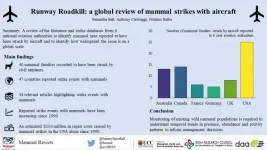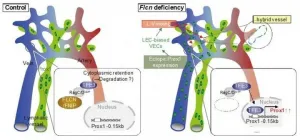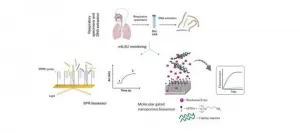(Press-News.org) Using patient data, artificial intelligence can make a 90 percent accurate assessment of whether a person will die from COVID-19 or not, according to new research at the University of Copenhagen. Body mass index (BMI), gender and high blood pressure are among the most heavily weighted factors. The research can be used to predict the number of patients in hospitals, who will need a respirator and determine who ought to be first in line for a vaccination.
Artificial intelligence is able to predict who is most likely to die from the coronavirus. In doing so, it can also help decide who should be at the front of the line for the precious vaccines now being administered across Denmark.
The result is from a newly published study by researchers at the University of Copenhagen's Department of Computer Science. Since the COVID pandemic's first wave, researchers have been working to develop computer models that can predict, based on disease history and health data, how badly people will be affected by COVID-19.
Based on patient data from the Capital Region of Denmark and Region Zealand, the results of the study demonstrate that artificial intelligence can, with up to 90 percent certainty, determine whether an uninfected person who is not yet infected will die of COVID-19 or not if they are unfortunate enough to become infected. Once admitted to the hospital with COVID-19, the computer can predict with 80 percent accuracy whether the person will need a respirator.
"We began working on the models to assist hospitals, as during the first wave, they feared that they did not have enough respirators for intensive care patients. Our new findings could also be used to carefully identify who needs a vaccine," explains Professor Mads Nielsen of the University of Copenhagen's Department of Computer Science.
Older men with high blood pressure are highest at risk
The researchers fed a computer program with health data from 3,944 Danish COVID-19 patients. This trained the computer to recognize patterns and correlations in both patients' prior illnesses and in their bouts against COVID-19.
"Our results demonstrate, unsurprisingly, that age and BMI are the most decisive parameters for how severely a person will be affected by COVID-19. But the likelihood of dying or ending up on a respirator is also heightened if you are male, have high blood pressure or a neurological disease," explains Mads Nielsen.
The diseases and health factors that, according to the study, have the most influence on whether a patient ends up on a respirator after being infected with COVID-19 are in order of priority: BMI, age, high blood pressure, being male, neurological diseases, COPD, asthma, diabetes and heart disease.
"For those affected by one or more of these parameters, we have found that it may make sense to move them up in the vaccine queue, to avoid any risk of them becoming inflected and eventually ending up on a respirator," says Nielsen.
Predicting respiratory needs is a must
Researchers are currently working with the Capital Region of Denmark to take advantage of this fresh batch of results in practice. They hope that artificial intelligence will soon be able to help the country's hospitals by continuously predicting the need for respirators.
"We are working towards a goal that we should be able to predict the need for respirators five days ahead by giving the computer access to health data on all COVID positives in the region," says Mads Nielsen, adding:
"The computer will never be able to replace a doctor's assessment, but it can help doctors and hospitals see many COVID-19 infected patients at once and set ongoing priorities."
However, technical work is still pending to make health data from the region available for the computer and thereafter to calculate the risk to the infected patients. The research was carried out in collaboration with Rigshospitalet and Bispebjerg and Frederiksberg Hospital.
INFORMATION:
Facts:
Data is processed on Computerome, a secure supercomputer for personal data, and under the permission of the Danish Patient Safety Authority, data owners and other relevant authorities.
Artificial intelligence predicts with 90 percent accuracy whether an infected patient will die of COVID-19.
Once a person is hospitalized with COVID-19, artificial intelligence can predict whether the person should be on a respirator with 80 percent accuracy.
BMI, age, high blood pressure, being male, neurological diseases, COPD, asthma, diabetes and heart disease are factors that artificial intelligence weigh`s most to with the risk of getting into the respirator.
The computer models are based on health data from 3,944 COVID-19 patients from the Capital Region and Region Zealand.
The article is published in the scientific journal Scientific Reports.
The study is supported by the Novo Nordisk Foundation and the Innovation Fund.
Contact
Mads Nielsen
Professor
Department of Computer Science
University of Copenhagen
Mobile: + 45 24 600 599
madsn@di.ku.dk
Michael Skov Jensen
Journalist
The Faculty of Science
University of Copenhagen
Mobile: + 45 93 56 58 97
msj@science.ku.dk
- World's wildlife, from giraffes to voles, kangaroos to coyotes being hit by aircraft.
- Study identifies incidences at airports in 47 countries across the globe.
- 'Runway Roadkill' increasing by up to 68% annually and has caused damage that has cost in excess of $103 million in the United States alone over a 30 year period.
- It is hoped study could pave way for international efforts to protect wildlife and reduce costly aircraft damage.
From giraffes to the world's smallest mammals, the world's wildlife is being increasingly struck by aircraft, a global study finds.
Airports from Sydney to London and the USA to Germany were examined by researchers who ...
LEBANON, NH - Dartmouth's and Dartmouth-Hitchcock's Norris Cotton Cancer Center (NCCC) is the first cancer center in the world to install BeamSite Cherenkov imaging cameras in its radiotherapy treatment rooms. The camera system, invented, validated and commercialized by entrepreneurs from NCCC and Dartmouth spinoff biomed tech company, DoseOptics, LLC, captures imaging and real-time video of the beam directly on the patient, allowing the radiation oncology team to visualize treatment delivery.
Cherenkov imaging makes radiation treatment a visual process. The Cherenkov effect occurs when photon or electron radiation beams interact with tissue, such as skin, producing a small light ...
University of Texas at Arlington researchers have developed a technique that programs 2D materials to transform into complex 3D shapes.
The goal of the work is to create synthetic materials that can mimic how living organisms expand and contract soft tissues and thus achieve complex 3D movements and functions. Programming thin sheets, or 2D materials, to morph into 3D shapes can enable new technologies for soft robotics, deployable systems, and biomimetic manufacturing, which produces synthetic products that mimic biological processes.
Kyungsuk Yum, an associate professor in the Materials ...
URBANA, Ill. ¬- Mealtimes are a central aspect of family life, affecting the health and wellbeing of both children and adults. Although the benefits of healthy mealtimes are straightforward, helping all families realize those benefits is quite complicated, new research from University of Illinois shows.
The study highlights ways in which some solutions - such as an exclusive focus on improving food access or on improving mealtime preparation and organization skills - may be less effective if done in isolation, says Allen Barton, assistant professor in the Department of Human Development and Family Studies at ...
Researchers from Kumamoto University (Japan) have clarified the mechanism by which blood and lymph vessels remain segregated from one another after development. The characteristics and structures of these two vessel types are very similar, and how they maintain separation has remained unexplained for many years. In this study, researchers found that the molecule Folliculin (FLCN) in vascular endothelial cells acts as a gatekeeper to maintain that separation.
Blood and lymphatic vessels form independent networks until the final confluence at the left and right venous angles in the neck. Blood vessels act as a pipeline that ...
We've all felt stressed at some point, whether in our personal or professional lives or in response to exceptional circumstances like the COVID-19 pandemic. But until now there has been no way to quantify stress levels in an objective manner.
That could soon change thanks to a small wearable sensor developed by engineers at EPFL's Nanoelectronic Devices Laboratory (Nanolab) and Xsensio. The device can be placed directly on a patient's skin and can continually measure the concentration of cortisol, the main stress biomarker, in the patient's sweat.
Cortisol: A double-edged sword
Cortisol is a steroid hormone ...
The group led by Dr. Enrique J. Calderón - "Clinical Epidemiology and Vascular Risk" at the Institute of Biomedicine of Seville - IBiS/University Hospitals Virgen del Rocío and Macarena/CSIC/University of Seville, also a member of CIBERESP, participated in a project with researchers from CIBER-BBN, in which they developed systems to detect Pneumocystis jirovecii, an atypical fungus responsible for very severe pneumonia in immunosuppressed patients. The results have been published in the journals Nanomaterials and Journal of Fungi, and are the fruit of collaboration with the CIBER-BBN groups led by Dr. Laura Lechuga, ...
The spinal column consists of 24 vertebrae that provide axial support to the torso and protection to the spinal cord that runs through its central cavity. The vertebrae are connected by means of intervertebral discs. These discs are highly hydrated, flexible and highly mechanically resistant. They allow the column its flexibility and act as shock absorbers during daily activities such as walking, running and in impact situations, such as jumping.
These unique features are made possible by the discs' tissue composition and structure. At its centre, there is a gel-like ...
At the time of writing, coronavirus disease 2019 (COVID-19) is seriously threatening human lives and health throughout the world. Before effective vaccines and specific drugs are developed, non-pharmacological interventions and numerical model predictions are essential. To this end, a group led by Professor Jianping Huang from Lanzhou University, China, developed the Global Prediction System of the COVID-19 Pandemic (GPCP).
Jianping Huang is a Professor in the College of Atmospheric Sciences and a Director of the Collaborative Innovation Center for Western Ecological Safety, Lanzhou University, China. He has for a long time been dedicated to studying ...
The Vlasov-Poisson equations describe many important physical phenomena such as the distribution of gravitating particles in the interstellar space, high-temperature plasma kinetics, and the Landau damping effect. A joint team of scientists from the Mathematical Institute of RUDN University and the Mathematical Institute of the University of Munich suggested a new method to obtain stationary solutions for a system of Vlasov-Poisson equations in a three-dimensional case. The obtained solutions describe the phenomena of stellar dynamics. The results of the study were published in the ...





